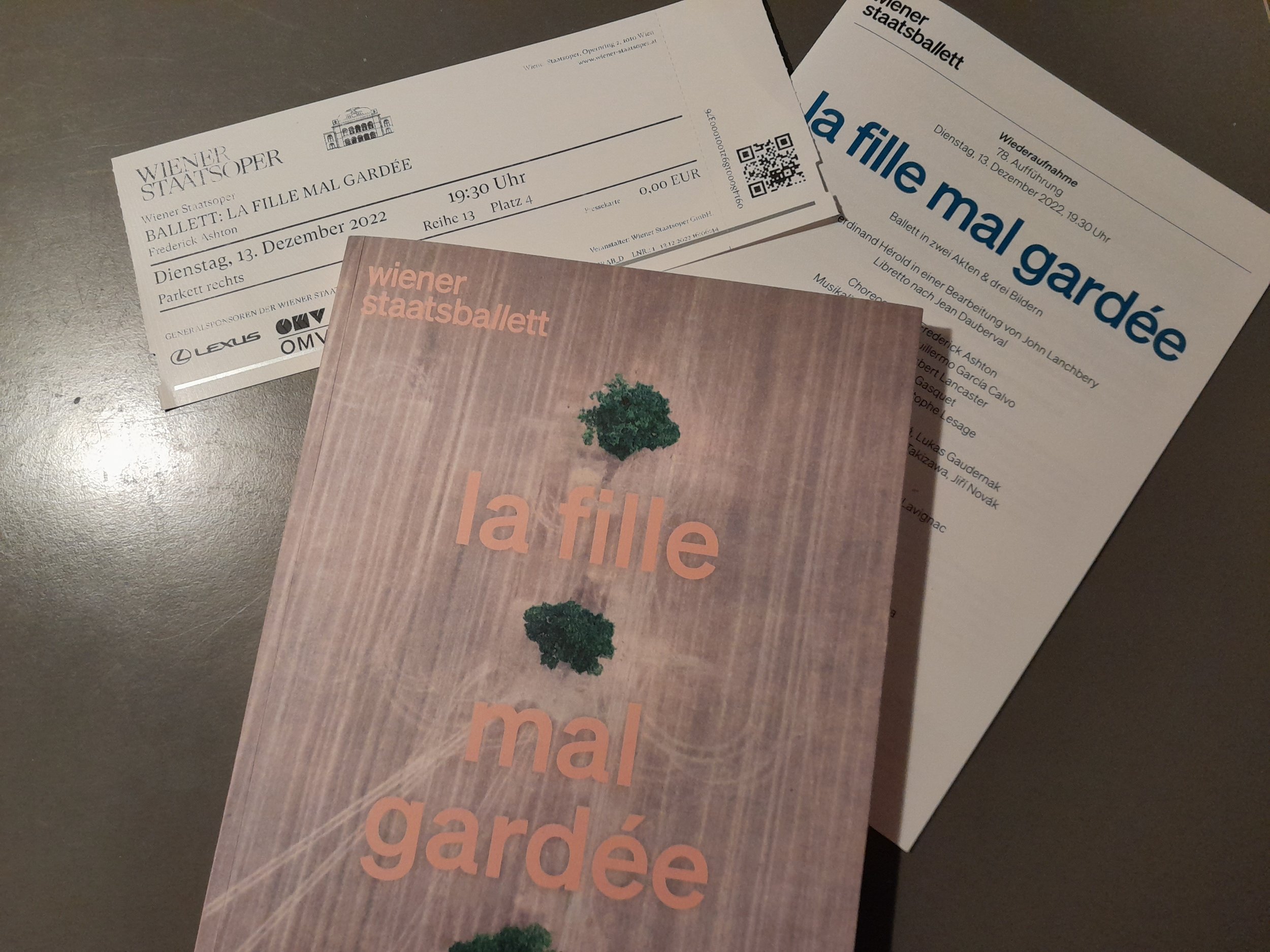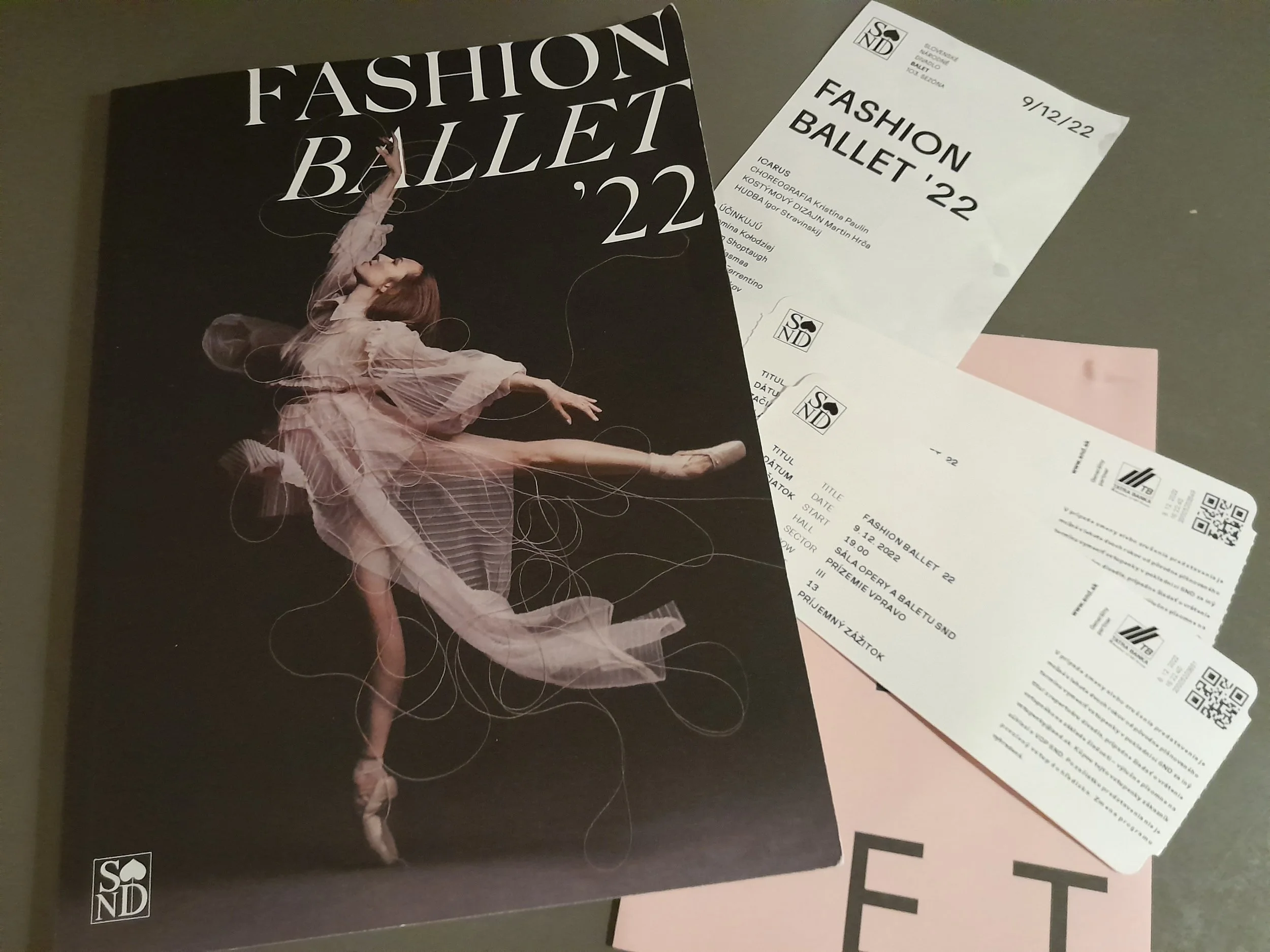"La Fille mal gardée": Vienna State Ballet, Dec. 13th, 2022 (Wiener Staatsballett)
„La Fille mal gardée“ is, what the plot is concerned, a very dull Ballet. Its nearly too lengthy use of pantomime (on the second act)„to tell a story“ makes one long for more dance moments, but shortly, as you may have guessed, not one of my all-time favourites. But this does not diminish its value, not in the least. One must watch it with great accuracy, scrutiny and most of all, with an enormous attentiveness to detail. The (typical) Sir Frederick Ashton technical challenges are not few and they cover a big range from the Soloists until the formations of the Corps de Ballet ,which require enormous discipline and the musicality of the written choreography, which requires (also from the Corps) more than just a pin-pointed exactitude (and I am definitely not meaning just ribbons and bands... ) and, of course as it is mostly the case with Sir Frederick Ashton, fleet-footed execution.
First of all, I would like to mention the always forgotten the rooster and the four hens. This „brood“ (Giulia Cacciatori, Nina Cagnin, Marie Ryba and Carolin Sachernegg – all young members of the „Vienna State Opera-Ballet Academy's Junior Company), led by talented Kristián Pokorný is more than delightful and brings us back to simple joys, so easy to revel in, especially during a „pre-Christmas time“, in which we all (well, I at least!) somehow have. They managed to do just that! And wonderfully!
Copyright: Ashley Taylor/ Vienna State Ballet
I have always considered the Village Notary and the (his) „Writer“ as completely needless, superfluous roles, which are quite irrelevant to the line of the plot. It felt somehow „sad“ and a waste to have such a good dancer as Zsolt Török portraying the Notary.
Copyright: Ashley Taylor/ Vienna State Ballet
Thomas (the wealthy proprietor of a vineyard), gorgeously portrayed by Igor Milos, and Daniel Vizcayo's Alain. His dramaturgically, extremely well conceived son, is perhaps, thanks to the line of story-telling the funniest role of the evening.
A beautiful display of professionalism, grace and wit is what Anita Manolova, Eszter Ledán, Sveva Gargiulo and Céline Janou Weder gave to the audience (and, on top of it, having loads of fun) while accompanying the widow Simone in the famous „Clog Dance“ and making it more possible for „her“ to appear funny... This is what I call REAL support work.
Copyright: Ashley Taylor/ Vienna State Ballet
Yes, Simone, the widow... There are no real character Dancers in the Company of the Vienna State Ballet – and this is a fact, since a long time. The „widow“ is conceived as an „elder woman“, a bit more on the „indulgent and fat side“ of life... In spite of all his efforts, François-Eloi Lavignac, a talented member of the Company, could not live up to the expectations of the Ballet, in what the Widow's changeable moods (and funny moments) in Ashton's choreography are concerned. Thinking of the great Brian Shaw (Royal Ballet), whose career was cut short on stage of the Metropolitan Opera, while on tour, after tearing an Achilles tendon, not only achieved great success as one of Cinderella's ugly Sister but also as „Simone“ (Well over 50!). Who is, in fact, responsible for the casting at the State Opera in Vienna? To the casting department I say: Aren't there are some elderly „ex dancers“ doing other jobs behind the scene that could „form“ a small group of character players? You know, Kings, Queens, Drosselmeyer, the widow... etc. et al?
Copyright: Ashley Taylor/ Vienna State Ballet
Sonia Dvořák started the evening's performance in quite a reserved way. Not vivaciously enough, not „central character“ enough. But she (slowly, very slowly) recovered from this, may I use the word, state of numbness and ended the first act and the evening in full-command of the role, timing. Although at the beginning of the first act, it was quite obvious, after she beautifully bourréed backwards, that she was was in full command technically playing the role: Miss Dvořák is technically, physically and artistically a perfect „Lise“. I wonder if she had „got the Willies“, a first night common reaction, and relaxed along the way... Whatever it was, she has the right „ingredients“ for a good „Fille“ and definitely overwhelmed that state of reserved display. She gave a very controlled but sweet performance. mastering the sometimes, very tricky Ashton's step combinations. There is still need of further work on end positions and finalizations altogether. But she “has” the role. She gives it life and tangible, plausible feelings. That is the most important and hardest thing in a role that is not „extreme“ (for its emotional displays), like Odette/Odile - the Good and the Evil - and tends to be simple and sometimes just tender, human, down-to-earth.
Copyright: Ashley Taylor/ Vienna State Ballet
Always handsome Géraud Wielick, looking this time very thin on stage, surprised me once more. Having turned into a fine, technically very good, young dancer, he gave a good and believable rendition of Colas – who is forced already at the beginning of the evening to go into a series of alternating pirouettes and tours en l'air in a diagonal, in such an early moment of the ballet. A moment in which most of other roles are still „warming up“. His construction of the character is lovely, warm and uncomplicated. Endearing. Captivating. Simplicity at its best. And the demands of the Ashton language with an extra dose of „fleet-footed work“. Chapeau! We could even call it instead of “La Fille mal gardée”, just “Le Garҫon bien audacieux”.
P.S. I do not understand why certain Companies use „La Fille“ as a „spring board“ for some dancers, like a „test“ to, sort of, determine if the dancers playing the two main roles, are „good and fit enough“ to achieve good performances in other roles. I repeat: I do not understand that for it places „Fille“ in the position of a „lesser work“ and this is a mistake which reveals an extreme lack of Knowledge.
I do not want to sound as instructively as the present direction of the Vienna State Ballet, quite an absurdity that deserves no further mention, but „just for the record“, one must explain to the new public at the Opera (as the most knowledgeable one is staying away) that Ashton is widely credited with the creation of the very specific English style.
„La Fille nal gardée“ (1960) has a distinct place among his best-known works (as „Cinderella“, that was once humourously but precisely described as „slapstick of celestial order“, „Symphonic“ „Variations“, „Façade“, „Enigma Variations“, „Monotones“ I and II, the fabulously sensitive „Marguerite et Armand“ and even The Tales of Beatrix Potter, one of his last... )
But, to make a long story short, what is this English style of ballet mentioned above? Just think of its épaulement (Note: The way the head and shoulders are held) and you will understand where I want to get to. The “Ashton style” is known for its elegance and has been strangely (but accurately) described as very „architectural“ as there is not a lot of movement in the upper body.
And what makes it so special? Elegance combined with breathtaking technical demands and this very distinctive use of épaulement, so to say, combined with fleet footwork.
And the most important question:
Where was that yesterday?
A friend of a friend of mine, someone who works on the Royal Ballet (and shall remain nameless here), was visiting Vienna and was quite intrigued with the photos displayed at the Opera to promote “Fille”. She said: “They don’t look at all like “Fille”. Do I have to say more? It is high time that somebody from „The Frederick Ashton Foundation“ or from The Royak Ballet (Someone like Judy Lincoln) flies over to control this production, which has been again rehearsed (and coached?) by Christophe Lesage (This was a point of a critique of mine back in... 2015?), who may be needing a „freshen-up“ in what Ashton's language and style are all about (To avoid any further misunderstandings and for a better comprehension of this issue, if one cannot fly to London to see The Royal Ballet perform Sir Frederick Ashton's „Fille“ at their „home“ in Covent Garden, there are several videos online and I recommend you the one with „The Clog Dance“ and Stanley Holden as the „Widow“ or the ones with David Wall and Ann Jenner. These are clearly (and cleanly) good examples of the above-mentioned „English style“).
At the end of the performance, the public was very kind and this is quite understandable - It had been quite a long time since the last “presentable” show. A colleague of mine, sitting beside me, said jokingly: “And no standing Ovations tonight?” (Another “absurd” behaviour that seems to be “in” now, to give standing ovations to “anything”… What are standing ovations now? What is their present meaning? Mere actions these days, that get tossed around, way to carelessly to the undeserving? I guess so… but… Think about that!
Ricardo Leitner
December 14th, 2022










